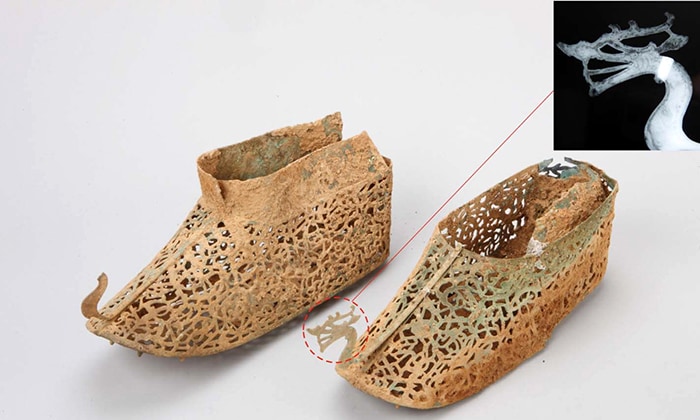The carvings on the shoes are as elaborate as embroidery. They are so intricate that it is hard to believe that the shoes are made of gold. At the toe of each shoe is placed a small dragon, rearing its head, as if it will rise in flight and take the entombed shoe-wearer with it into the sky.


A pair of golden shoes found in 2014 in an ancient tomb near Naju is currently on display at the Naju National Museum. The centuries have barely affected its shape and decorations.
Mahan is an ancient kingdom existent on the Korean Peninsula before the Three Kingdoms of Korea (57 B.C.-A.D.935). Though it’s not clear exactly when it was founded, historical records help historians date Mahan to a time before Baekje (18 B.C.-A.D. 660) was founded.
The “History of the Three [Korean] Kingdoms” (1145), or “Samguk Sagi,” records that King Onjo (d. A.D. 28), the founder of Baekje, sent envoys to Mahan. The “Records of the [Chinese] Three Kingdoms” (c. 200s), or the “Sanguozhi” in Mandarin, also has some records about Mahan. Considering these records, historians calculate that Mahan was first located in the western parts of the Korean Peninsula and later slowly merged with Baekje as Baekje grew stronger and more powerful.


Earthenware (top) found along with the ‘dragon shoes’ and other pieces of armor from ancient Mahan (bottom) are currently on display at the Naju National Museum. The armor can be experienced through a 3-D video.
This exhibition on Mahan historical artifacts is being held today centuries later, but still in the geographic center of the ancient kingdom. The exhibit includes about 450 artifacts that were excavated and examined by the Naju National Research Institute of Cultural Heritage over the past decade. Along with the golden shoes, earthenware coffins are also on display. The people of Mahan are believed to have preferred using earthenware tombs. Pieces of armor worn by Mahan warriors have been restored and are on display, and can be experienced through 3-D videos. Finally, videos of the excavations and the research process can be seen at the exhibition, too.
The special exhibition about the Mahan kingdom will continue until Dec. 20.
By Chang Iou-chung
Korea.net Staff Writer
Photos: Cultural Heritage Administration
icchang @korea.kr























